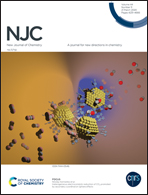Al/Zn co-incorporated Cu–In–Se quantum dots for high efficiency quantum dot sensitized solar cells†
Abstract
Although Cu–In–Se (CISe) quantum dots (QDs) with narrow tunable bandgap and low toxicity have promising prospects in photovoltaics, their application is seriously restricted by high defect density. To develop a facile synthesis method for high-quality CISe QDs, Al and Zn ions were introduced into the synthesis of CISe QDs. Compared with the incorporation of Al or Zn alone, the trap-state defects in CISe QDs can be more effectively reduced by the co-incorporation of these metal ions. The synthesized CISe QDs then were used as light harvester materials to fabricate photoanodes for constructing quantum dot sensitized solar cells (QDSCs). The photovoltaic performance of the QDSCs based on Al/Zn co-incorporated QDs was observed to be much better than that of the QDSCs based on Al or Zn alone incorporated QDs, which could be ascribed to the suppression of unfavorable charge combination in QDSCs. A power conversion efficiency (PCE) of 10.27% (Jsc = 27.15 mA cm−2, Voc = 0.620 V, and FF = 61.0%) was achieved on the QDSCs with Cu2S/brass counter electrodes and polysulfide electrolyte under simulated one full sun illumination, which is among the reported best PCEs of the QDSCs with a similar structure.



 Please wait while we load your content...
Please wait while we load your content...